Respiratory ‘WOF’ and follow up improves Māori and Pacific children’s asthma management
A Hastings community pharmacy’s project to improve asthma management in a group of Māori and Pacific children has left everyone breathing easier.
Hawke’s Bay Māori and Pacific children have a much higher rate of hospital admissions for respiratory disease (7.3 and 10.4 per 1000 respectively) compared with New Zealand European children (4.5 per 1000).
Unichem Russell St Pharmacy developed the quality improvement project, working in partnership with adjacent medical centre, The Doctors Hastings Medical Centre, primary health organisation Health Hawke’s Bay’s clinical advisory pharmacist and respiratory support service, Breathe Hawke’s Bay.
Families of Māori and Pacific children waiting at the pharmacy for their asthma medication were invited to have an asthma control test (ACT), quick respiratory ‘warrant of fitness’ and education session with a pharmacist.
Twelve families agreed to take part in the project, which aimed to improve the children’s target ACT score by the end of the six-month project.
Pharmacist and project lead, Samantha Tie, says rather than use the prescribed ACT target score of good control (19 out of 25), patients and their families chose their own target score and personal aims, such as having no asthma attacks or waking less at night.
The patients’ average ACT score increased from 13.7 to 21.7, with 83 percent achieving their target score. More preventer inhalers were dispensed and fewer emergency steroids.
Ms Tie says a variety of interventions were used to improve the patients’ asthma management.
These included checking if they were on a preventer inhaler and reviewing their technique, seeing if an asthma action plan was in place and understood, monthly follow up phone calls, checking if other family members also had asthma, smoking cessation advice and referral for a healthy home check.
She says key to the project’s success was delivering the education sessions within the pharmacy as well as providing patients with tools which pharmacies aren’t normally funded to provide. This included spacer’s which are a specially designed plastic tube for use with a puffer inhaler.
‘We found that a lot of patients were coming in for a repeat prescription having not seen their GP, and having misplaced their spacer and not understanding why they needed to use one.
‘Now doctors prescribe a spacer and sign a supply order for them, but they are kept at the pharmacy for distribution. The Hawke’s Bay District Health Board (DHB) has let all pharmacies know that it supports them distributing spacers.’
Ms Tie says the DHB also supported the project through Medicines Use Review (MUR) funding to cover the pharmacists’ time to carry out the warrant of fitness and education.
The project was undertaken as part of the 2018 Whakakotahi quality improvement programme, which aims to increase quality improvement capability in primary care and support the key focus areas of equity, integration, consumer engagement and consumer co-design.
Successful providers are supported by the Commission to implement quality improvement projects in an area of patient care that is important to their patients or community and to them as providers.
The Commission’s primary care programme team supports and mentors participating primary care teams through site visits and group learning events, and a member of each project team is offered a position on the primary care quality improvement facilitator course delivered by Ko Awatea and the Commission's primary care and leadership capability programmes.
Ms Tie says she learnt a lot from the project.
‘The support from the Commission has been fantastic. From not knowing anything about quality improvement to be able to run a project achieving these results has been great and we now apply quality improvement principles to every project in the pharmacy.
‘We’re also really encouraged to see that other pharmacies are involved in Whakakotahi 2019.’
She says the project was shared at a MUR peer review and the DHB sees merit in supporting the pharmacy to continue this work using MUR funding.
‘We’re going to share the project’s template to other pharmacies and we’re now looking at using the tools for other long-term conditions such as diabetes, cardiac conditions and gout.’
Other benefits of the project have included opening up communication channels with the patients and their families so that collecting their prescriptions has become more than a transaction.
‘They know now that they can phone us any time if they have any questions about their medication.
‘Most of them were also unaware of the existence of Breathe Hawke’s Bay and the free services it offers, so they are all now linked in there, if they need help further down the track.
‘And, in some cases, others in the extended family also have asthma, so they were able to receive the same education messages about seeing their doctor if they felt their asthma wasn’t under control.’

An infographic outlining the childhood respiratory warrant of fitness project. Download a copy of the graphic (955KB, JPG)
